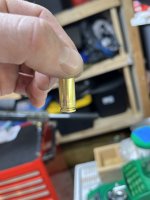To follow up on what I was saying with Quick Load or the other internal theoretical ballistics model:
Here’s Hodgdon’s published data on the 90gr TNT on top of Benchmark, a compressed load, next to QL:
6.5 Grendel
Benchmark
2.200” COL
30.5gr compressed load
90gr TNT
47,000psi
It’s one of the lowest published chamber pressures for a max charge in 6.5 Grendel that I’m aware of. They couldn’t get anymore in the case basically even with a compressed load, at the short COL that is driven by such a short bullet.
An even lower one is this:
90gr TNT
8208XBR
31.0gr Compressed
2.220” COL
42,400psi
Enter those in and see what either of the internal engines kicks out for you.
QL shows 51,939psi for the 8208XBR load under 90gr TNT, which is 9,539psi higher than Hodgdon’s pressure test breech measured in the real world.
In GRT, it predicted:
Benchmark: 56,108 psi and 104.3% case fill. This is 9,108psi higher than Hodgdon’s real world numbers.
For 8208XBR: 52,674 psi and 103.5% case fill. This is 10,274psi higher than Hodgdon’s real world measurements.
Here’s Hodgdon’s published data on the 90gr TNT on top of Benchmark, a compressed load, next to QL:
6.5 Grendel
Benchmark
2.200” COL
30.5gr compressed load
90gr TNT
47,000psi
It’s one of the lowest published chamber pressures for a max charge in 6.5 Grendel that I’m aware of. They couldn’t get anymore in the case basically even with a compressed load, at the short COL that is driven by such a short bullet.
An even lower one is this:
90gr TNT
8208XBR
31.0gr Compressed
2.220” COL
42,400psi
Enter those in and see what either of the internal engines kicks out for you.
QL shows 51,939psi for the 8208XBR load under 90gr TNT, which is 9,539psi higher than Hodgdon’s pressure test breech measured in the real world.
In GRT, it predicted:
Benchmark: 56,108 psi and 104.3% case fill. This is 9,108psi higher than Hodgdon’s real world numbers.
For 8208XBR: 52,674 psi and 103.5% case fill. This is 10,274psi higher than Hodgdon’s real world measurements.
Last edited:







